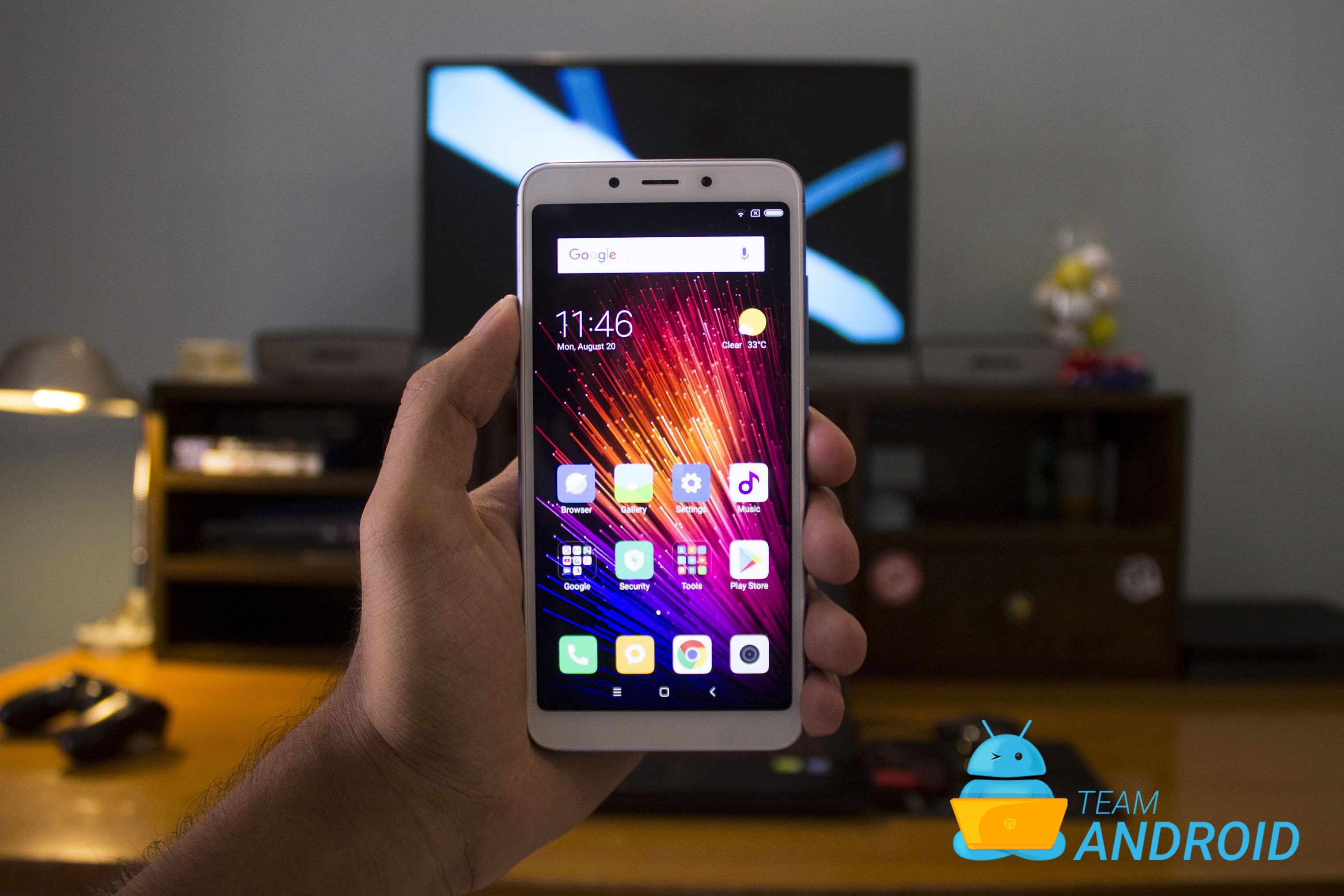As dual camera lenses become a standard on modern Android smartphones, Xiaomi has unveiled its 2018 budget iteration equipped with this technology, the new Redmi 6. Deemed as Entry-level dual camera king, new Redmi 6 has a lot to offer. Xiaomi’s take with the Redmi lineup has always been to provide respectable hardware at competitive prices. Further, the design philosophy for these smartphones is to appeal to young buyers. Latest Redmi 6 follows these same essentials but tries to stand out with its dual camera setup. We will be taking a detailed look at the device as a whole in this review. A big shout out to Mi Pakistan for sending in this phone to review!
On top of the headlining dual cameras on the rear, Redmi 6 comes equipped with Helio P22 chipset which offers an octa-core processor based on 12nm technology. For Xiaomi, this is a key aspect to the device as within this price-point, counterparts offer much less performance. Also, to make better use of this hardware, Redmi 6 runs latest MIUI 9 — Xiaomi’s Android skin. From this brief look, Redmi 6 has a lot to offer but does it stand up with the strong competition? We will take a look in detail right ahead.

For us Android enthusiasts, a spec-sheet is the first thing to gauge a device so here are all the detailed specs of Xiaomi Redmi 6
- Network: Dual SIM 4G Support (GSM / FDD / TDD / WCDMA)
- Display: 5.45″ 18:9 full screen, 1440 x 720, 295 PPI
- Processor: Helio P22 octa-core processor, 12nm technology, up to 2.0GHz
- OS: Android 8.1 (Oreo)
- Camera Rear: 12MP + 5MP AI rear dual camera
- Camera Front: 5MP front camera
- Connectivity: MicroUSB, 3.5mm Headphone Jack, Bluetooth® 4.2
- Sensors: Fingerprint sensor, Vibration motor, Proximity sensor, Ambient light sensor, Electronic compass, Accelerometer
- Memory: 3 GB RAM + 32 GB internal storage / 4 GB RAM + 64 GB internal storage
- Dimension: 147.5m x 71.5mm x 8.3mm
- Battery: 3,000mAh
Xiaomi Redmi 6: Design and Hardware

Following a youthful theme, Redmi 6 features a curvier design with rounded edges. Our specific variant came in Blue color whereas users can also choose from Grey, Gold and Rose Gold options. The rear of the device is made from metal which then mates up with the glass at front seamlessly. For our variant, the front was painted white, if you opt for the Grey color then there would be a black painted front panel.
Speaking further of the design, the main design element that is unique to the Redmi 6 and is probably the best distinguishing factor from other Android smartphones, is the speaker cut-out on the back. Being subtle as it is, this cut-out gives Redmi 6 a unique design character. For the speaker placement itself, this is quite a unique choice. Compared to being placed on the bottom edge, this has its own pros and cons. For the pros, having speakers firing back, users would not be able to block them completely when holding the device in landscape. As for the downsides, back-firing speakers have decreased volume and also, don’t work when phone is laid flat on a table with the screen up.

Also on the rear is the dual camera module which is placed in a landscape setup alongside the fingerprint sensor. It is 2018 and now, big brands like Xiaomi have detailed experience with biometric verification so the fingerprint scanner on Redmi 6 had no issues and was aptly quick. Moving to each side, the device follows a pretty standard layout, the power buttons and volume buttons are placed on the right, microUSB on bottom and 3.5mm headphone jack on top. Unfortunately, the volume buttons are housed in a singular elongated button and there is no texture difference between them and power button.
Onto the front, Redmi 6 features a 18:9 display at a resolution of 1440×720. To fit 18:9 panel into this phone, the brand had to bring down the resolution essentially to 720p. Personally, I would’ve gone with a 1080p panel whilst keeping the normal 16:9 resolution. Fortunately enough, despite the phone not having a 1080p output, Xiaomi didn’t throttle its rear camera to fit the native resolution rather you can shoot videos at 1080p with the Redmi 6. To finish the front side, there is the standard front facing camera, sensors, flash and notification light.
Taking a look at Redmi 6’s internals, Helio P22 12nm processor stands out. To accompany it, Xiaomi ships two variants, one comes with 3GB RAM and 32GB ROM whereas the higher end variant has 4GB RAM and 64GB ROM — the one we received. Despite Redmi 6 coming with expandable storage, we recommend you go with the higher end 4GB RAM smartphone to get best performance. For our tests, Redmi 6 performed well with day to day tasks such as browsing, video playback and attending calls. As for demanding apps, Redmi 6 slightly struggles which is expected at this price range. You can take a look at the ahead attached benchmarks to get a better look at Redmi 6’s performance.
Xiaomi Redmi 6: Camera

Camera has been the focus point for budget smartphones for quite some time now. Users are looking towards great photos and videos rather than performance and other statistics. Realizing this, Xiaomi has packed dual cameras on Redmi 6. The main sensor is 12MP and accompanying it is a smaller 5MP camera. In combination, Redmi 6 uses this setup to offer Portrait photographs — pictures with blurry backgrounds such as from a DSLR. In our usage, we liked quite a few shots from Redmi 6 however, we also found few problems. Focus and shutter both were quite slow, regardless of lighting conditions. We have attached some test shots from Redmi 6 right ahead so you can see how the smartphone performs. You would notice duplicate photos, one is taken in normal mode whereas the one with the more blurry background is taken using Portrait mode. As for video, we like the fact that Redmi 6 has 1080p recording capabilities despite having a 720p screen.

Closing off, there is a standard 5MP camera on the front. This module is just okay. To overcome hardware shortcomings, Redmi 6 uses software techniques to enhance the image taken. You can chose from a set of Beautifying settings to get the best photos.
Xiaomi Redmi 6: Connectivity, Memory and Battery

4G network is now closer to being a global standard and having that in mind, Xiaomi has equipped Redmi 6 with industry standard communication and connectivity capabilities. Further as Redmi 6’s key markets consider dual SIM as a key feature, it supports 4G but on both of its SIM slots. For memory, there are two variants available. The base model comes with 3GB RAM and 32GB of storage whereas the higher end has 64GB storage and 4GB RAM. Storage can easily be expanded with microSD on the Redmi 6 but as RAM is soldered on, we recommend you go with the 4GB variant.
For battery, Redmi 6 has a 3,000 mAh module which lets users utilize the smartphone for a whole day with mixed usage. Despite adding heft and thickness, we applaud Xiaomi for fitting such a large battery in the Redmi 6. Unfortunately however, there is no fast charging support of any kind.
Xiaomi Redmi 6: Software

As essential as hardware is for any non-Google Android smartphone, the software is equally as important. Xiaomi’s Redmi 6 runs the brands latest MIUI 9 software based on Android Oreo. What we absolutely love about MIUI is its customization options. You can change a lot of stuff within the stock OS to make your Redmi 6 unique. Further, the skin is quite light and works quite well with Redmi’s hardware.
UI tweaks within this skin are quite extensive as well. If you are used to stock Android or any other Android skin, you will find MIUI a great refresh and innovative take at Android. Within this skin, there is a lot of emphasis on colors and focus on small details. For instance, if you have a clock widget on your home screen, once you swipe to it, you will notice that the notification bar clock hides itself to remove redundancy.
Further, there are a number of MIUI proprietary apps that offer great functionality right out of the box. Most might think of this as bloat but we found all Mi apps to be quite helpful.
Default bundled Xiaomi Apps & Features:
- Xiaomi Notes: For your Note taking needs, the Notes app is default on Redmi 4X. You can store all your notes here and sync them with your Mi Account.
- Xiaomi Explorer: To view all the stored offline files on your Redmi 4X, the Explorer app comes as stock. You can categorize your files or view them all at once like you do on a desktop computer.
- Xiaomi Security: The Security app is a multi-purpose maintenance app. It not only monitors the security side of your smartphone but also allows you to monitor the phone, create automated tasks, clean files, free up space and more.
- Xiaomi Tools App Bundle: The Tools bundle on the Redmi 4X includes multitudes of apps that might come in handy. For starters, you will find the stock Mail client, Contacts app, Calculator and Clock. Mi Account app comes included as well and this app allows you to monitor your Mi Account and retrieve data from it. Other utilities include a Feedback app, Updater app, Downloads app, Compass app and a Universal Scanner app.















































